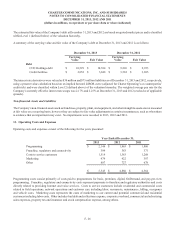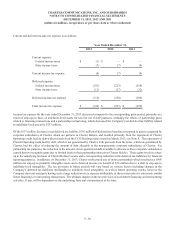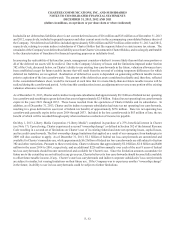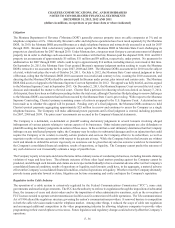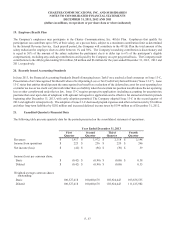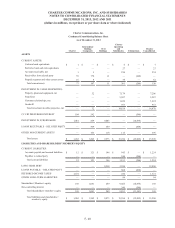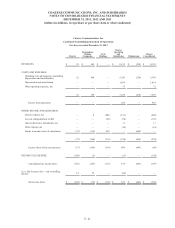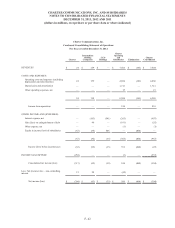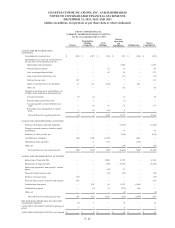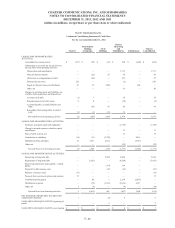Charter 2013 Annual Report Download - page 118
Download and view the complete annual report
Please find page 118 of the 2013 Charter annual report below. You can navigate through the pages in the report by either clicking on the pages listed below, or by using the keyword search tool below to find specific information within the annual report.CHARTER COMMUNICATIONS, INC. AND SUBSIDIARIES
NOTES TO CONSOLIDATED FINANCIAL STATEMENTS
DECEMBER 31, 2013, 2012 AND 2011
(dollars in millions, except share or per share data or where indicated)
F- 36
Litigation
The Montana Department of Revenue ("Montana DOR") generally assesses property taxes on cable companies at 3% and on
telephone companies at 6%. Historically, Bresnan's cable and telephone operations have been taxed separately by the Montana
DOR. In 2010, the Montana DOR assessed Bresnan as a single telephone business and retroactively assessed it as such for 2007
through 2009. Bresnan filed a declaratory judgment action against the Montana DOR in Montana State Court challenging its
property tax classifications for 2007 through 2010. Under Montana law, a taxpayer must first pay a current assessment of disputed
property tax in order to challenge such assessment. In accordance with that law, Bresnan paid the disputed 2010, 2011 and 2012
property tax assessments of approximately $5 million, $11 million and $9 million, respectively, under protest. No payments for
additional tax for 2007 through 2009, which could be up to approximately $16 million, including interest, were made at that time.
On September 26, 2011, the Montana State Court granted Bresnan's summary judgment motion seeking to vacate the Montana
DOR's retroactive tax assessments for the years 2007, 2008 and 2009. The Montana DOR's assessment for 2010 was the subject
of a trial, which took place the week of October 24, 2011. On July 6, 2012, the Montana State Court entered judgment in favor
of Bresnan, ruling that the Montana's DOR 2010 assessment was invalid and contrary to law, vacating the 2010 assessment, and
directing that the Montana DOR refund the amounts paid by Bresnan under protest, plus interest and certain costs. The Montana
DOR filed a notice of appeal to the Montana Supreme Court on September 20, 2012. The appeal was fully briefed, and was argued
to the Montana Supreme Court in September 2013. On December 2, 2013, the Montana Supreme Court reversed the trial court’s
decision and remanded the matter to the trial court. Charter filed a petition for rehearing which was denied on January 7, 2014.
At this point, there have been no further proceedings before the trial court, although Charter has filed pleadings to renew challenges
to the Montana DOR’s assessments that had been mooted by the Montana State Court’s prior ruling. With respect to the Montana
Supreme Court ruling, Charter’s primary remaining course of action is an appeal to the U.S. Supreme Court. A decision has not
been made as to whether this appeal will be pursued. Pending entry of a final judgment, the Montana DOR continues to hold
Charter's protest payments aggregating approximately $25 million in escrow and continues to assess the Company as a single
telephone business. The Company will make additional protest payments until a final judgment is entered, including payments
for 2007, 2008 and 2009. The prior years' assessments are accrued in the Company's financial statements.
The Company is a defendant, co-defendant or plaintiff seeking declaratory judgments in several lawsuits involving alleged
infringement of various patents relating to various aspects of its businesses. Other industry participants are also defendants or
plaintiffs seeking declaratory judgments in certain of these cases. In the event that a court ultimately determines that the Company
infringes on any intellectual property rights, the Company may be subject to substantial damages and/or an injunction that could
require the Company or its vendors to modify certain products and services the Company offers to its subscribers, as well as
negotiate royalty or license agreements with respect to the patents at issue. While the Company believes the lawsuits are without
merit and intends to defend the actions vigorously, no assurance can be given that any adverse outcome would not be material to
the Company's consolidated financial condition, results of operations, or liquidity. The Company cannot predict the outcome of
any such claims nor can it reasonably estimate a range of possible loss.
The Company is party to lawsuits and claims that arise in the ordinary course of conducting its business, including lawsuits claiming
violation of wage and hour laws. The ultimate outcome of these other legal matters pending against the Company cannot be
predicted, and although such lawsuits and claims are not expected individually to have a material adverse effect on the Company’s
consolidated financial condition, results of operations or liquidity, such lawsuits could have, in the aggregate, a material adverse
effect on the Company’s consolidated financial condition, results of operations or liquidity. Whether or not the Company ultimately
prevails in any particular lawsuit or claim, litigation can be time consuming and costly and injure the Company's reputation.
Regulation in the Cable Industry
The operation of a cable system is extensively regulated by the Federal Communications Commission (“FCC”), some state
governments and most local governments. The FCC has the authority to enforce its regulations through the imposition of substantial
fines, the issuance of cease and desist orders and/or the imposition of other administrative sanctions, such as the revocation of
FCC licenses needed to operate certain transmission facilities used in connection with cable operations. The Telecommunications
Act of 1996 altered the regulatory structure governing the nation’s communications providers. It removed barriers to competition
in both the cable television market and the telephone market. Among other things, it reduced the scope of cable rate regulation
and encouraged additional competition in the video programming industry by allowing telephone companies to provide video
programming in their own telephone service areas. Future legislative and regulatory changes could adversely affect the Company’s
operations.


